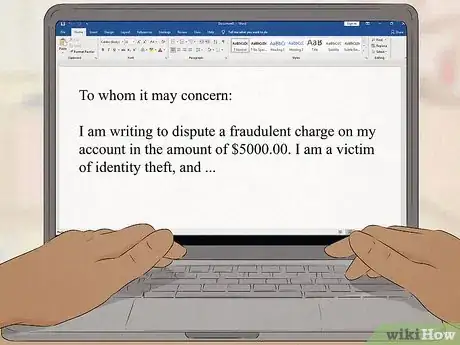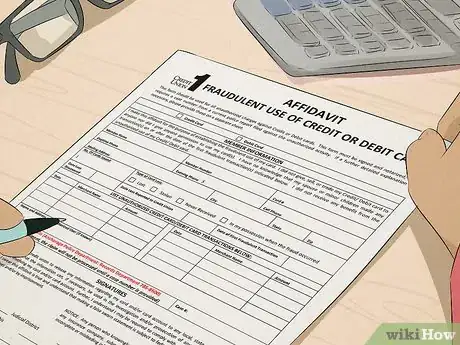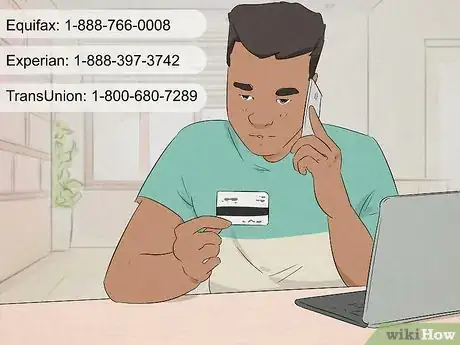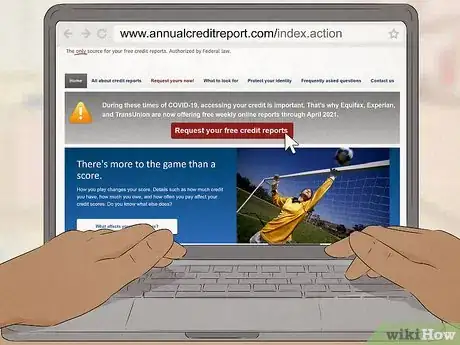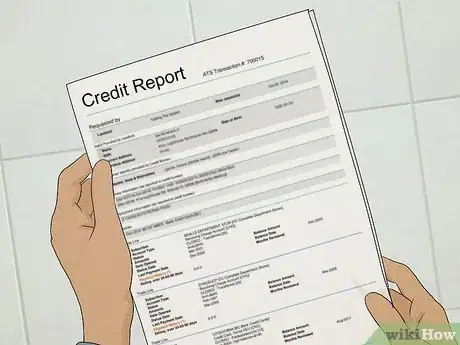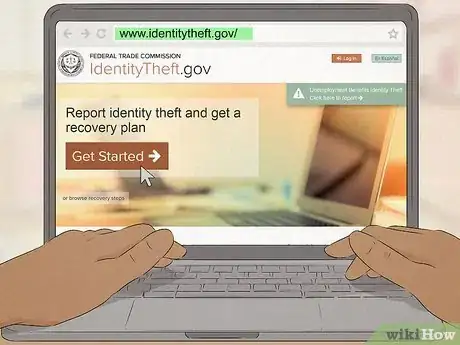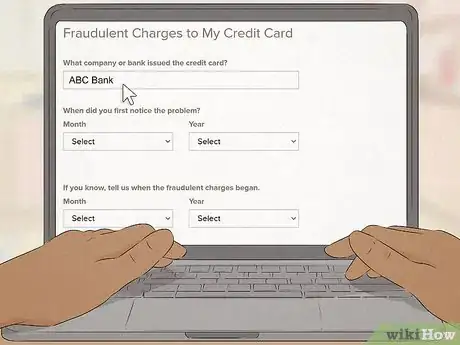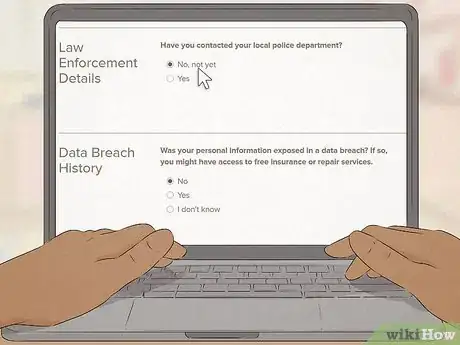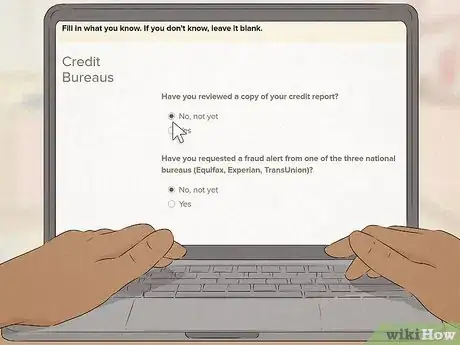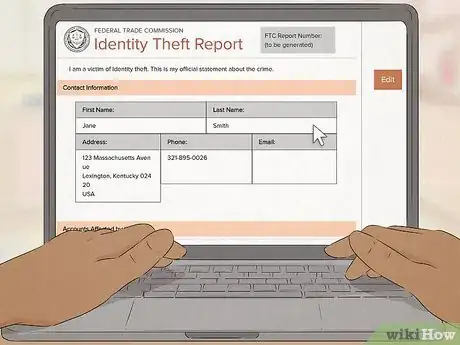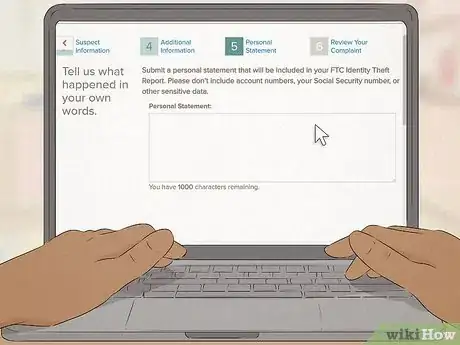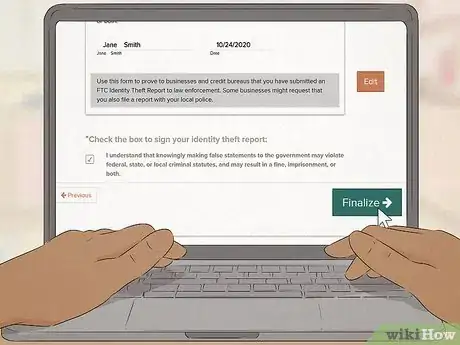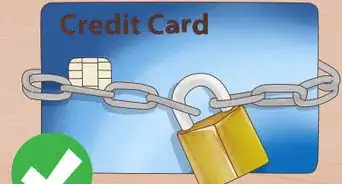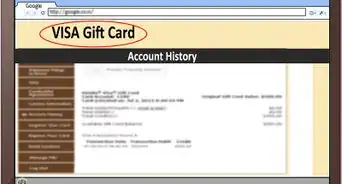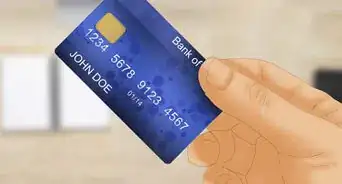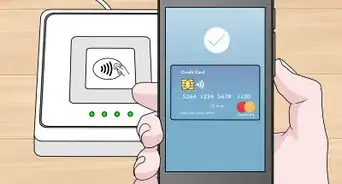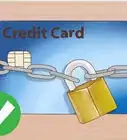This article was co-authored by Michael R. Lewis. Michael R. Lewis is a retired corporate executive, entrepreneur, and investment advisor in Texas. He has over 40 years of experience in business and finance, including as a Vice President for Blue Cross Blue Shield of Texas. He has a BBA in Industrial Management from the University of Texas at Austin.
There are 10 references cited in this article, which can be found at the bottom of the page.
This article has been viewed 260,329 times.
Have you noticed some weird purchases or otherwise strange activity on your credit card? Suspicious activity or unrecognized charges on your credit card statement might be signs of identity theft. If you believe you are the victim of credit card fraud, it is imperative to act quickly. Identity theft and accounted for more than 13 percent of consumer complaints registered with the Federal Trade Commission (FTC) in 2014.
Things You Should Know
- Call up your card issuer as soon as you notice any fraudulent activity on your card. Follow up with a written letter, and fill out a fraud affidavit about your case.
- Contact your local police and report credit card fraud. Hold onto a copy of the police report, and use the case number on file if you want to follow up with your case.
- Contact 1 of 3 major credit bureaus (TransUnion, Equifax, and Experian) and place a fraud alert on your file.
- Fill out the FTC's online complaint form and provide plenty of information about the identity theft that occurred.
Steps
Notifying Your Card Issuer
-
1Call your card issuer. Call immediately as soon as you suspect fraudulent activity. The toll free number of your credit card issuer can be found on the back of your credit card. If your card has been lost or stolen, refer to the list of credit issuers’ contact information published by CreditCards.com.[1]
- Once you notify your card issuer, they will initiate an investigation. Your card issuer will also contact merchants and reverse any fraudulent charges. You are not responsible for any charges that occur once you report the fraud.[2]
- Federal law states that if you are unable to report a lost or stolen card before it is used, you can only be held liable for up to $50 of fraudulent charges.
-
2Follow up with written notification. Send a letter to your credit card issuer. Include your credit card number and the date you initially filed the report. If your card was lost or stolen, reference the date in the letter. If your found suspicious or fraudulent activity on your statement, report that information in the letter.[3]Advertisement
-
3Complete a credit card fraud affidavit. The credit card issuer may send you a fraud affidavit. If they don’t, complete an FTC Identity Theft Affidavit. This is a formal statement of the facts surrounding your case.[4] You will need this affidavit when reporting the fraud to the police and to the credit reporting agencies.[5]
- Sign and date the form in the presence of a law enforcement officer or a notary.[6]
- The affidavit will ask for personal information, such as your name, address and Social Security number.
- You will be asked to report information about the fraud, such as the name of the person who used your credit card (if you know it) and any other information you know about the crime.
Filing a Police Report for Unauthorized Charges
-
1Contact the police department in the city where you live. You can go to the police station or ask for an officer to come to your home. Provide any relevant information you know about the credit card fraud. Be prepared to share your personal information and to provide your contact information.[7]
- You do not have to pay any fees to file a police report.
- You will need your credit card fraud affidavit. Use the one provided by your card issuer or the FTC Identity Theft Affidavit.
- Have a government-issued photo identification with you, such as a driver’s license.
- Bring proof of your address, such as a copy of your mortgage statement or a utilities bill.
- Submit proof of the theft, such as credit card statements or IRS notices.
-
2Keep a copy of the police report and the case number. Ask for a copy of the police report to keep for your records. The police department will issue a case number for your report. Refer to the case number if you have to contact the police about your case.
-
3Understand why filing a police report is necessary. The Federal Deposit Insurance Corporation (FDIC) recommends filing a police report. The police may not be instrumental in identifying the person who committed the fraud. However, filing a report firmly establishes your innocence should you need to contest charges down the road. In addition, filing a police report notifies law enforcement authorities about financial crimes that are occurring in the area.
Contacting Credit Bureaus
-
1Place a fraud alert with one of the three credit reporting bureaus. The three credit reporting bureaus are TransUnion, Equifax and Experian. You only need to contact one of them. Once you do, that agency will contact the other two.[8]
- Visit Equifax Credit Report Assistance, or call 1-888-766-0008.
- Go to the Experian Fraud Center, or call 1-888-397-3742.
- Go to the TransUnion Fraud Alert page, or call 1-800-680-7289.
- The credit reporting agencies will send you a letter to verify that the fraud alert has been placed on your file.
- Placing a fraud alert is free. It remains on your file for 90 days.
- A fraud alert protects you because it requires businesses to contact you before issuing credit in your name.[9]
-
2Obtain a copy of your credit report. Placing a fraud alert entitles you to a free copy of your credit report. Follow the directions on your fraud alert confirmation to obtain your credit report.
- You can also get a free credit report once per year from annualcreditreport.com or by calling 1-877-322-8228.
- If you have already received your free credit report, you can pay any of the credit reporting agencies to receive an immediate copy of your credit report.[10]
-
3Review your credit report. Note any unusual or suspicious activity. Look for unauthorized transactions on your credit card accounts. Report any unauthorized credit activity to the credit issuer. Use information from your credit report when completing your police report and your report to the FTC.[11]
Filing FTC Report
-
1Complete the Federal Trade Commission’s (FTC’s) online complaint form. Select the identity theft category. Then select the appropriate subcategory related to your case, such as data breach, lost wallet or purse or identity theft. Follow the prompts to submit all of the relevant information about the crime. Skip any items that don’t apply to you, and provide as many details as you can.[12]
-
2Give details about the identity theft. Provide the date on which you noticed the identity theft. Indicate how much time and money you have spent trying to resolve the matter yourself. Submit details about the credit issuer and the type of credit account that has been used. Indicate whether you intend to file a complaint against the company. Tell whether you have been contacted by debt collectors about this account.[13]
-
3Provide information about the person who stole your identity. If you know who stole your identity or fraudulently used your credit card, fill out what you know. Provide the person’s name and address. Indicate how the person is related to you, if applicable. Note how you think the person got a hold of your information.[14]
-
4Tell whether or not you have contacted law enforcement. If you have filed a police report, include this information. Provide the date you filed the police report. Indicate the name and location of the police department. Fill in the name of the officer who took the report. Provide the officer’s contact information.[15]
-
5Provide information about fraud alerts. Indicate whether you have contacted any of the credit bureaus and placed a fraud alert on your file. Note whether you have a complaint about any of the credit reporting agencies. Identify what information on your credit report is now inaccurate as a result of the crime. Provide information about credit inquiries that appear on your report as a result of the identity theft.[16]
-
6Verify your identity. Provide information verifying your identity, such as your name, address and contact information. Indicate how long you have lived at your current address. Provide your driver’s license number if you have one. Include your date of birth and your Social Security number.
-
7Tell your story in your own words. In the comments section of the document, you can write about what happened. Provide any additional information that wasn’t covered in any of the previous sections. Don’t repeat your Social Security number, date of birth or any account numbers in this section. You can enter up to 1000 characters in this section.[17]
-
8Review and submit your complaint. Review the information you have provided. Make any necessary edits. Once you are satisfied that the information is correct, click on “Submit” to file your complaint with the FTC. Print out a copy of the complaint and keep it for your records.
References
- ↑ http://www.creditcards.com/privacy-security-suite/if-youre-a-victim.php
- ↑ http://www.consumer-action.org/modules/articles/recognizing_credit_card_fraud_english#Topic_10
- ↑ http://www.consumer-action.org/modules/articles/recognizing_credit_card_fraud_english#Topic_10
- ↑ https://www.rocketlawyer.com/article/affidavit-definition.rl
- ↑ http://www.consumer-action.org/modules/articles/recognizing_credit_card_fraud_english#Topic_10
- ↑ https://www.consumer.ftc.gov/
- ↑ https://www.identitytheft.gov/
- ↑ https://www.identitytheft.gov/
- ↑ http://www.consumer.ftc.gov/articles/0275-place-fraud-alert
- ↑ https://www.identitytheft.gov/
- ↑ https://www.identitytheft.gov/
- ↑ https://www.identitytheft.gov/
- ↑ https://www.identitytheft.gov/TheftInformation
- ↑ https://www.identitytheft.gov/Suspect
- ↑ https://www.identitytheft.gov/AdditionalInformation
- ↑ https://www.identitytheft.gov/AdditionalInformation
- ↑ https://www.identitytheft.gov/Comments

